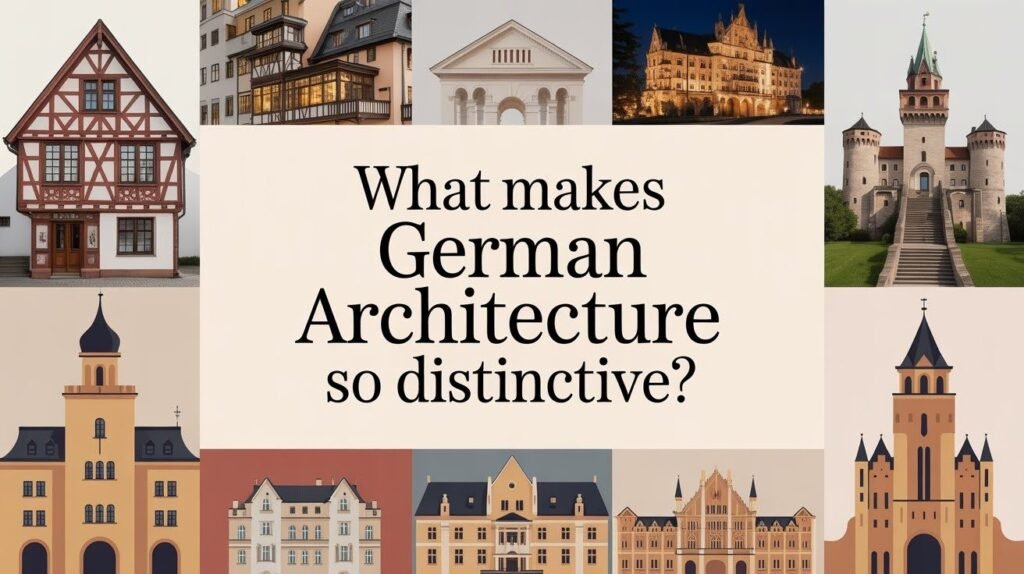Germany stands out architecturally through its remarkable combination of historical preservation, innovative design, and exceptional craftsmanship.
This nation has produced some of the world’s most influential architectural movements, from Gothic cathedrals and medieval castles to the revolutionary Bauhaus school and contemporary sustainable buildings.
German architecture reflects deep cultural identity, blending traditional techniques with forward-thinking approaches that continue to shape global design standards.
The country’s architectural landscape tells stories of resilience, creativity, and technical excellence.
From timber-framed houses in Bavaria to modern glass structures in Berlin, German buildings showcase both respect for heritage and commitment to innovation.
This post examines the distinctive elements that make German architecture so compelling, including its historical influences, construction methods, design philosophies, and lasting impact on worldwide architectural development.
A Timeline of Architectural Evolution
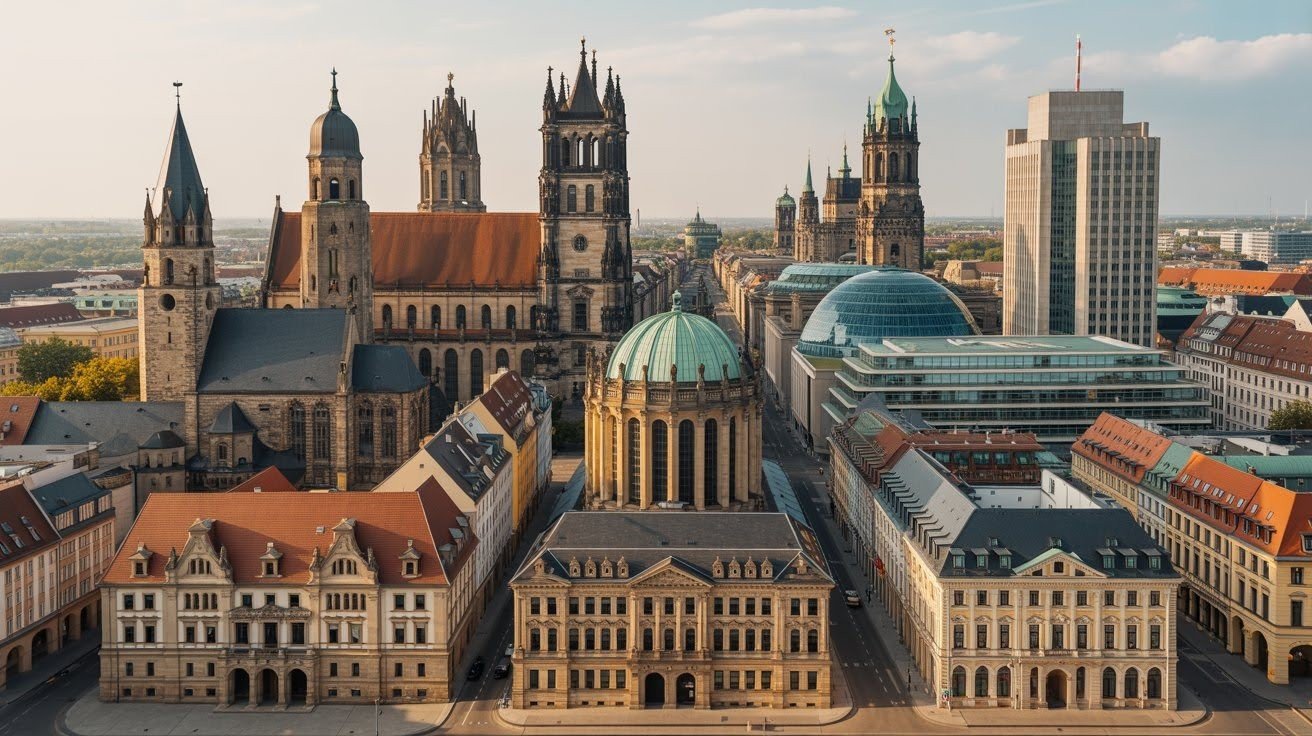
German architecture spans centuries, from medieval foundations to modern innovations, creating distinctive urban landscapes throughout the country.
From Medieval to Modern
German architecture spans over a millennium, beginning with Romanesque foundations and Gothic innovations that established technical mastery traditions.
Renaissance and Baroque periods brought Italian influences while maintaining distinctive craftsmanship.
The 19th century introduced Historicism and Neoclassicism, creating grand civic buildings reflecting national confidence.
The revolutionary Bauhaus movement emerged in the early 20th century, fundamentally changing global design philosophy regarding function and form.
Following wartime destruction, postwar reconstruction balanced historical restoration with innovative contemporary design.
Today, Germany leads sustainable architecture, combining environmental consciousness with cutting-edge technology.
A Living Museum of Styles
German cities present remarkable architectural diversity with centuries of building styles coexisting harmoniously.
Berlin showcases medieval churches near sleek glass towers, while restored Baroque palaces neighbor contemporary museums. Dresden offers similar variety, with reconstructed historic centers adjacent to modern developments.
These urban landscapes create fascinating dialogues between past and present. Medieval streets wind between modern skyscrapers, while Gothic cathedrals overlook contemporary districts.
This coexistence reflects German culture’s respect for history combined with innovation enthusiasm.
Regional Diversity in Building Traditions
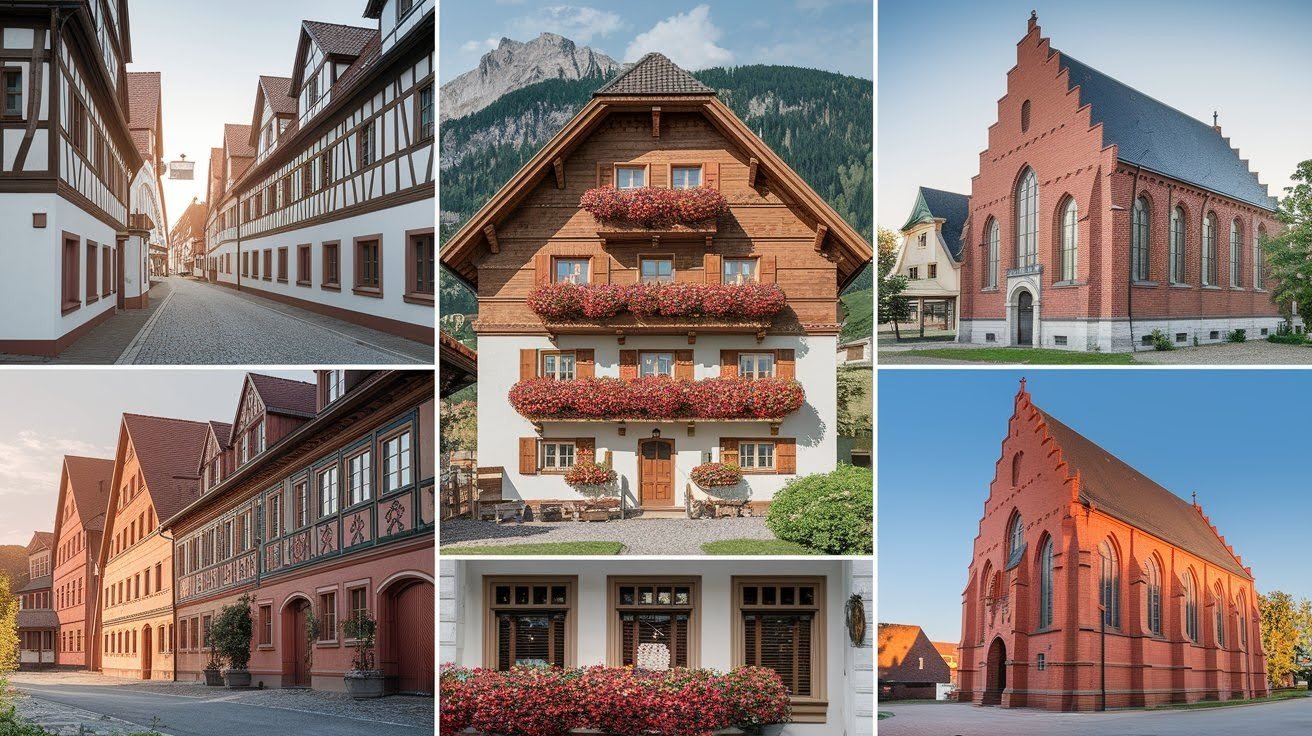
Germany’s architectural character varies dramatically by region, reflecting local materials, climate needs, and cultural heritage across different areas.
Half-Timbered (Fachwerk) Houses
- These iconic structures appear throughout German towns like Quedlinburg and Wernigerode, featuring exposed timber frames filled with plaster or brick materials.
- The construction method combines structural efficiency with visual appeal, creating the distinctive cross-hatched patterns that define traditional German streetscapes.
- Fachwerk represents both functional building techniques and cultural heritage, with each region developing unique decorative variations while maintaining core structural principles.
Alpine & Bavarian Styles
- Southern Germany features chalet-inspired homes with steep pitched roofs designed for heavy snow loads and wide balconies that provide outdoor living space.
- These structures emphasize natural wood construction with painted trim details and distinctive overhanging eaves that protect walls from weather.
- The style reflects mountain living requirements while creating warm, inviting residential architecture that complements the natural landscape.
Northern Germany’s Brick Gothic
- Cities like Hamburg and Lübeck showcase magnificent brick construction techniques developed during the Hanseatic League era.
- This regional style emerged from local clay resources and maritime trade wealth, creating imposing structures that demonstrate both technical skill and economic power.
- Brick Expressionism later evolved from these medieval foundations, producing bold architectural statements that remain influential in contemporary German design.
Iconic German Architects Who Shaped the World
German architects and designers have profoundly influenced global architecture through innovative movements and groundbreaking building techniques.
1. Karl Friedrich Schinkel
Master of Neoclassicism who created Prussian grandeur through refined classical proportions and monumental civic architecture.
Notable works include the Altes Museum and Neue Wache in Berlin, which established templates for museum design worldwide.
His approach balanced ancient Greek and Roman influences with German building traditions, creating a distinctive national architectural identity that influenced public building design across Europe.
2. Walter Gropius & the Bauhaus School
Founded the revolutionary design school that became the birthplace of modern architecture and industrial design principles.
Established “function meets form” philosophy emphasizing minimal, rational design that prioritized practical use over decorative elements.
The movement’s influence spread globally, fundamentally changing how architects approach residential, commercial, and institutional building design throughout the 20th century and beyond.
3. Mies van der Rohe & Ludwig Hilberseimer
Developed the International Style featuring clean lines, glass façades, and architectural purity that defined modern urban landscapes.
Their minimalist approach emphasized structural honesty and spatial flow, creating buildings that appeared to float above the ground.
Both architects moved from Germany to influence architecture worldwide, particularly in American cities during the mid-20th century, establishing principles still used today.
4. Sir Norman Foster in Berlin & Frankfurt
British architect who created modern German icons including the glass dome atop the Reichstag building in Berlin.
The Commerzbank Tower in Frankfurt demonstrates sustainable high-rise design with natural ventilation and energy-efficient systems.
His work in Germany showcases how contemporary architecture can respectfully integrate with historical urban contexts while addressing modern environmental concerns and functional requirements.
Germany’s Architectural Masterpieces
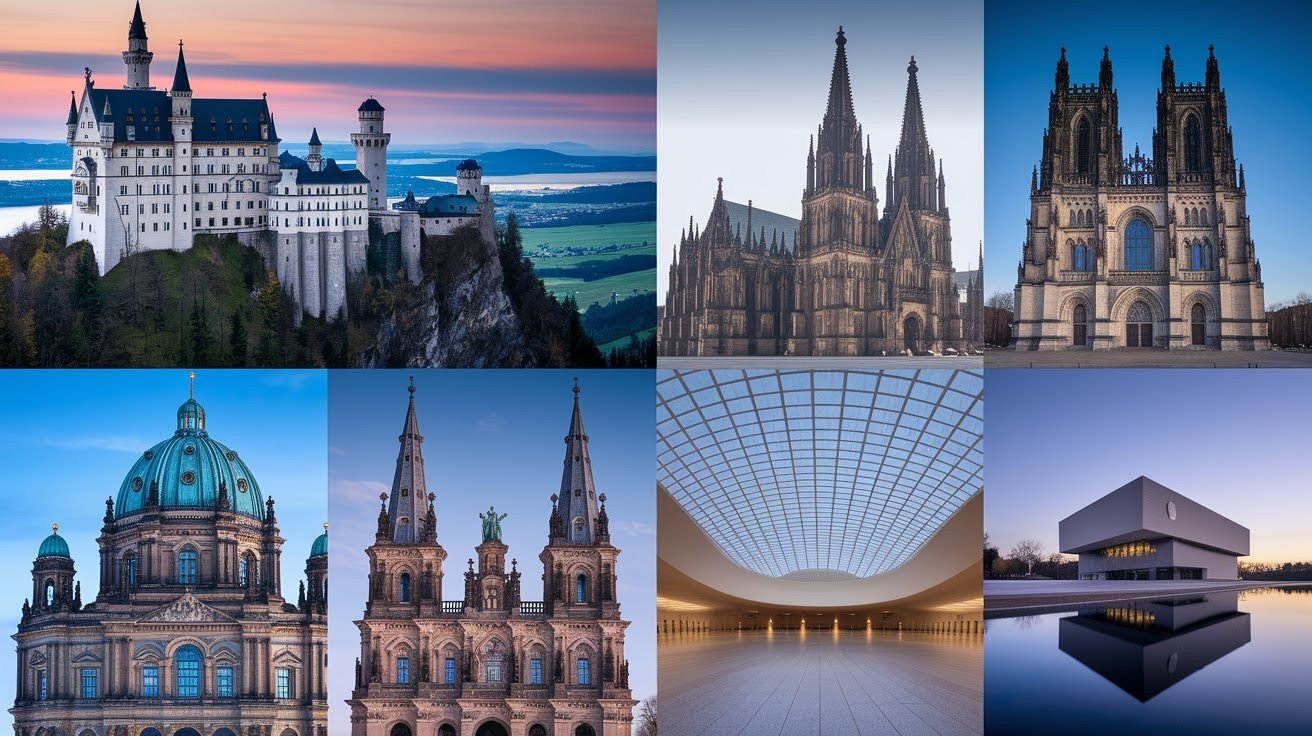
Germany houses extraordinary buildings that showcase centuries of architectural excellence, from fairytale castles to cutting-edge contemporary structures.
Castles & Palaces
Neuschwanstein Castle represents the pinnacle of romantic revival fantasy, commissioned by King Ludwig II as a theatrical interpretation of medieval fortress design.
This Bavarian masterpiece combines Gothic Revival elements with 19th-century engineering innovations, creating the iconic structure that inspired countless fairy tale illustrations.
Hohenzollern Castle demonstrates Gothic revival architecture positioned dramatically on a mountaintop, showcasing how German builders adapted historical styles to spectacular natural settings while maintaining defensive functionality.
Churches & Cathedrals
Cologne Cathedral stands as towering Gothic glory, featuring twin spires that dominated the city skyline for centuries and represent masterful stone construction techniques.
This monumental structure required over 600 years to complete, demonstrating German persistence and architectural ambition.
Frauenkirche Dresden serves as a reconstructed Baroque landmark, rebuilt after wartime destruction using original materials and traditional craftsmanship methods, symbolizing cultural resilience and commitment to preserving architectural heritage.
Modern Landmarks
The Elbphilharmonie in Hamburg combines historic brick warehouse foundations with contemporary glass wave-like superstructure, creating a stunning acoustic performance space.
Berlin’s New National Gallery showcases minimalist steel and glass design principles, housing world-class art collections within an architecturally significant modernist framework.
City Library Stuttgart features bold geometric forms and innovative interior spaces that redefine public library design for the 21st century.
Innovation & Sustainability in Contemporary Design
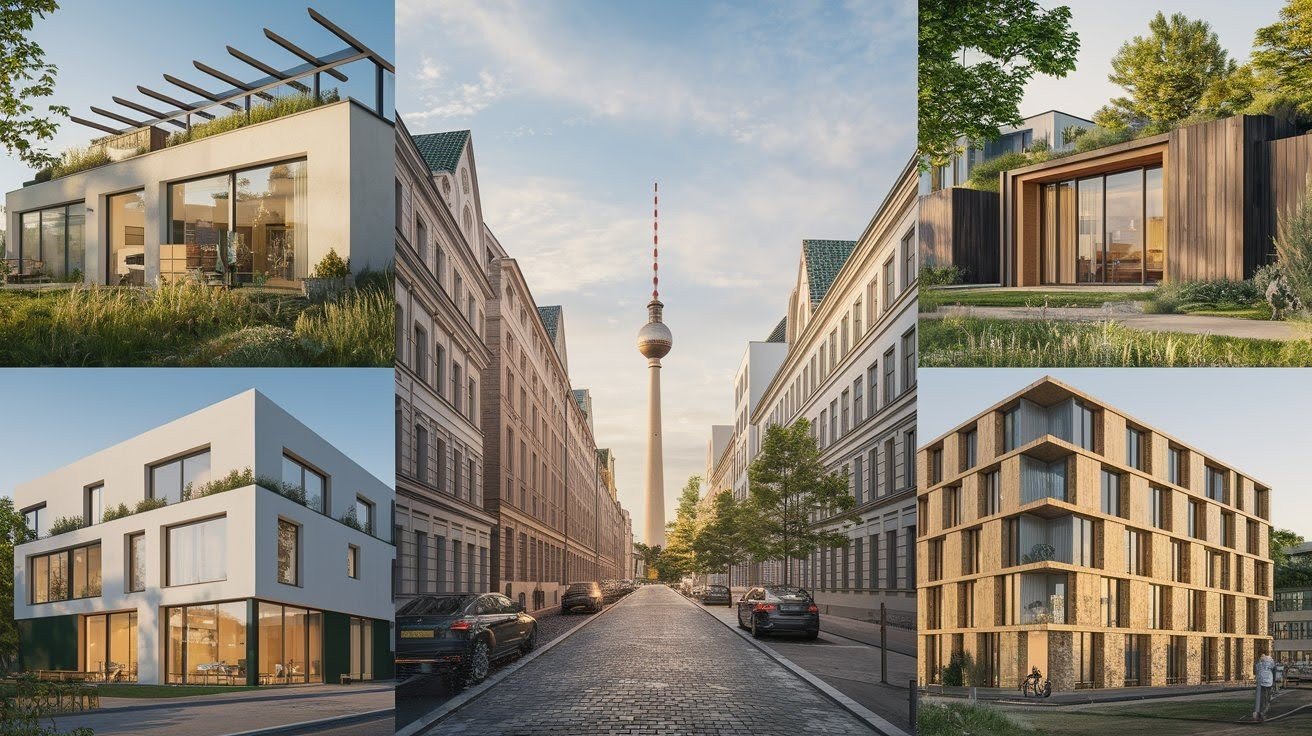
Germany leads global sustainable architecture through cutting-edge environmental technologies and innovative urban planning approaches that prioritize ecological responsibility.
Energy-Efficient Building Practices
- Germany pioneered passive house standards that drastically reduce energy consumption through superior insulation, airtight construction, and heat recovery ventilation systems.
- Solar architecture integrates photovoltaic panels and thermal collectors seamlessly into building design, creating structures that generate their own energy.
- Green roofs provide natural insulation while managing stormwater runoff and creating urban habitat spaces.
- Prefabricated homes utilize ecological materials like sustainably harvested timber and recycled components, reducing construction waste and environmental impact while maintaining high quality standards.
Urban Regeneration
- Berlin’s transformation following reunification demonstrates masterful urban planning that respects historical context while addressing contemporary needs.
- The city successfully integrated East and West architectural traditions, creating cohesive urban fabric that celebrates both heritage and innovation.
- Adaptive reuse projects breathe new life into industrial buildings, converting former gasometers into cultural venues and transforming abandoned factories into mixed-use developments.
- These regeneration efforts preserve architectural history while meeting modern housing and commercial demands, creating vibrant neighborhoods that honor the past while serving present communities.
Architecture as Cultural Storytelling
German buildings serve as powerful narratives that chronicle the nation’s complex history, social changes, and cultural values through stone and steel.
A Reflection of Political and Social History
Post-WWII rebuilding efforts created powerful memorials like the Kaiser Wilhelm Memorial Church, where damaged ruins stand alongside modern reconstruction to commemorate wartime destruction and renewal.
Cold War divisions become visible through contrasting urban planning approaches between East and West Berlin, with different architectural philosophies reflecting opposing political ideologies.
Memorial architecture throughout the country addresses difficult historical periods, using design to promote remembrance and reconciliation.
Preservation Meets Progress
Strong heritage conservation laws protect historical buildings while allowing thoughtful contemporary additions that respect original architectural integrity.
New buildings carefully coexist with centuries-old structures, creating urban environments where medieval churches share streetscapes with modern office towers.
Planning regulations require new construction to consider existing architectural context, preventing jarring disruptions while maintaining visual harmony across different periods.
Conclusion
German architecture captivates global audiences through its unique balance of tradition and modernity, creating built environments that honor the past while addressing contemporary needs.
This distinctive approach demonstrates that form can follow function without sacrificing character, resulting in structures that are both practical and meaningful.
From medieval cathedrals to Bauhaus innovations and sustainable contemporary buildings, Germany consistently produces architecture that tells compelling stories.
Travelers, architects, and design enthusiasts return repeatedly to experience this rich architectural landscape firsthand.
The country’s ability to preserve historical treasures while creating cutting-edge modern structures offers inspiration for designers worldwide.
German architecture proves that buildings can be simultaneously functional, beautiful, and culturally significant, setting standards that continue influencing global design practices and urban planning approaches.
Frequently Asked Questions
What architectural styles is Germany most famous for?
Germany is renowned for Gothic cathedrals, half-timbered (Fachwerk) houses, and the revolutionary Bauhaus movement that changed modern design worldwide. The country also features impressive Baroque palaces and contemporary sustainable buildings that lead global environmental standards.
How does German architecture differ between regions?
Northern Germany showcases distinctive brick Gothic structures, while southern Bavaria features Alpine-style chalets with steep roofs. Central regions display abundant half-timbered buildings, with each area developing unique construction methods based on local materials.
What makes German castles so distinctive compared to other European castles?
German castles combine defensive functionality with romantic architectural elements, particularly during the 19th-century revival period. Structures like Neuschwanstein blend medieval fortress design with Gothic Revival details, creating fairytale-like appearances that influenced popular culture.
How did the Bauhaus movement change architecture globally?
The Bauhaus school established “form follows function” principles that prioritized practical design over decorative elements. This movement influenced international architecture for decades, establishing design principles that continue shaping contemporary buildings and urban planning.
Why is Germany considered a leader in sustainable architecture?
Germany pioneered passive house standards and integrated renewable energy systems into building design decades before other countries. The nation’s commitment to environmental responsibility produces buildings that generate their own energy while maintaining high comfort standards.


